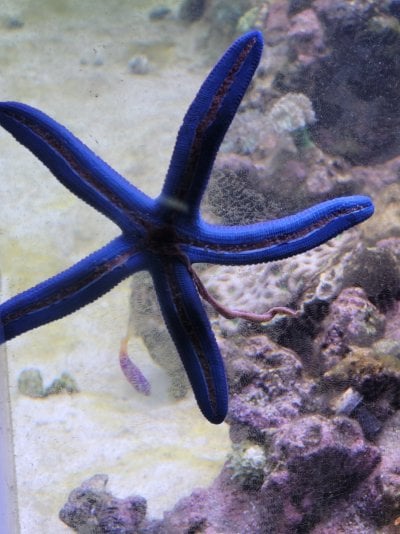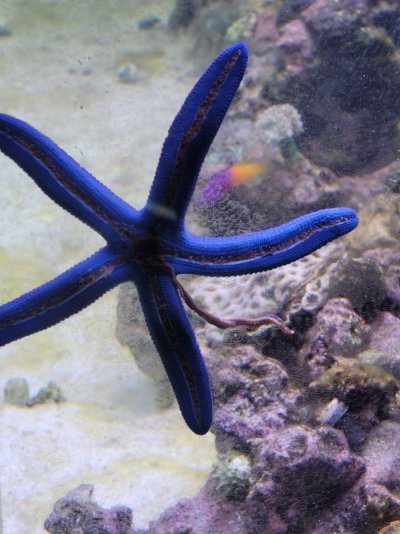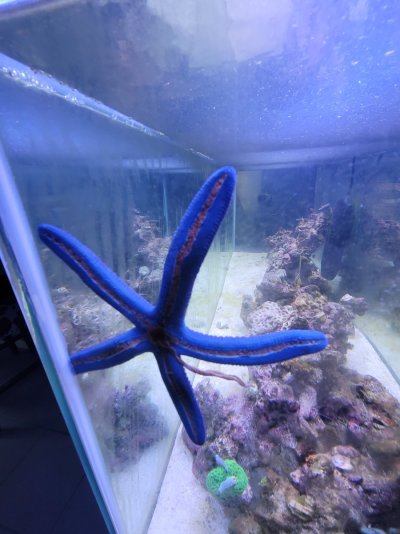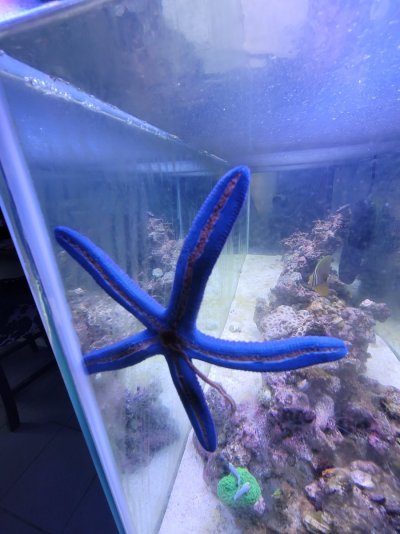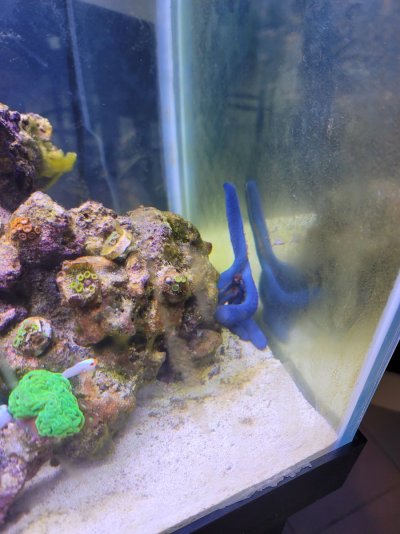Navigation
Install the app
How to install the app on iOS
Follow along with the video below to see how to install our site as a web app on your home screen.
Note: This feature may not be available in some browsers.
More options
You are using an out of date browser. It may not display this or other websites correctly.
You should upgrade or use an alternative browser.
You should upgrade or use an alternative browser.
Starfish Help!
- Thread starter saltnewbie101
- Start date
- Tagged users None
Cool star.
Have no idea.
Bump for you.
Have no idea.
Bump for you.
Linka star fish are extremely hard to keep. My guess is it's dying.
Why do you say that? First starfish so we're not real familiarStar will starve in that tank.
Not enough food for them. They typically waste away pretty quickly.Why do you say that? First starfish so we're not real familiar
Only star, I’ve kept long term was a sand sifting star. But they can be tough as well.
Well you asked for help but I’m not sure you’ve really gotten it.
Blue Linckia laevigata, like other seastars, are opportunistic predators and scavengers. They invert their stomachs and begin to digest their food externally. Food items include dead animals, small invertebrates, and detritus.
Here is a Reef2Reef article about care for a Linckia starfish
And another link that talks about care and feeding
Blue Linckia laevigata, like other seastars, are opportunistic predators and scavengers. They invert their stomachs and begin to digest their food externally. Food items include dead animals, small invertebrates, and detritus.
Here is a Reef2Reef article about care for a Linckia starfish
And another link that talks about care and feeding
Thank you.. your right, until this no real help only confirmation there's a problem. I just want to know what went wrong and how to correct it going forward.Well you asked for help but I’m not sure you’ve really gotten it.
Blue Linckia laevigata, like other seastars, are opportunistic predators and scavengers. They invert their stomachs and begin to digest their food externally. Food items include dead animals, small invertebrates, and detritus.
Here is a Reef2Reef article about care for a Linckia starfish
And another link that talks about care and feeding
How long have you had the starfish?
I've seen this issue a few times, and no one seems to actually know what it is, but it tends to happen with new stars - sometimes they survive like nothing happened, and other times they die:
I’ve seen people speculate that this is just the star everting it’s stomach to eat - it is almost certainly not. There are enough photos and videos of starfish eating with their everted stomachs these days to pretty well rule that out. I’ve seen one person claim this is the star spitting out damaged tube feet and that they do this often in the wild - I can find exactly zero evidence to support that claim, and I find it rather dubious (if anyone has evidence of this, I would be very curious to see it).
My unprofessional guess is that this is some sort of intense stress response or a bacterial infection of some kind (probably resulting from stress and/or less than ideal food/water conditions). Interestingly, most of the cases that I’ve seen that I can recall this with have happened similarly to your own (meaning this issue started about 2-3 weeks after they purchased the stars and added them to their tanks).
It’s possible it’s something with your tank parameters/conditions (such as high organic nutrients that, to my understanding, don’t read on most hobbyist tests), or something happened during the acclimation process, or even that the star was having unseen issues before you got it/the issues may have been caused by issues that occurred before you got it. I’m not sure.
From what I’ve seen, normally when stars die in aquaria they start dropping limbs and disintegrating (it kind of looks like they’re turning to ash). This looks different to me.
With regards to starfish starving in our tanks - yeah, most of them seem to starve/die within ~8-13 months (sometimes they die within the first few weeks though).
For Linckia starfish specifically (along with Fromias, Nardoas, etc.), they're though to be biofilm-eating starfish - so we can't replicate their diets, and they pretty well always end up starving even if target fed.
Some Linckia feeding comments and ways to gauge starfish health:
*As a note on the visual inspection - sometimes there are more subtle cues like the star looking lean (which can be tough to notice) or their spikes wearing down.Yeah, they'll eat Aquilonastra ("Asterina") stars, sponges, tunicates, etc. They're thought to be biofilm eaters in the wild, but - as you've noted - they'll occasionally scavenge for food too:
One important thing to keep in mind with foods for these guys - just because they eat it, doesn't mean it's meeting their nutritional needs; it might be, but it might not be. With how long it seems to take these guys to starve, unless you're monitoring their health closely, you might not notice if it's not meeting their needs until it's too late.Yeah, some people believe that the "Asterinas" (technically Aquilonastras) the Linckias eat allow their stars to survive in their tanks - I've suggested people may want to try farming them to feed their Linckias as a result. They likely do also eat tunicates and sponges, as those tend to be bacterial sinks (so they'd basically replicate biofilm for the stars to feed on).
Genuinely glad to hear they're doing well for you - please keep us updated on how it goes, as most of the time I've heard these stars typically die off around ~8-13 months in our tanks (though I've heard of them making it to ~2-3 years if there are Aquilonastra stars in the tanks with them - they seem to basically wipe the Aquilonastra population out after/around that time).
Some ways to potentially gauge the health of the starfish that may be useful:
1 - Visual: is anything visually wrong with the specimen? (From what I know of starfish, these cues are generally pretty obvious if they're there at all - if the starfish is disintegrating, there's something wrong).
2 - Weight: is the specimen putting on or maintaining weight (generally healthy), or is it losing weight (under most circumstances, this would be unhealthy)?
3 - Size/Length: if it's not already full size, is the specimen growing? Is it shrinking (either from weight loss, disease, limb loss, etc.)?
4 - Reproduction: is the specimen engaging in reproductive behaviors/activities (i.e. courting, nesting, spawning, etc.)? (I recognize this one is not as common of an indicator in captive starfish at this point, but there are a few instances of starfish attempting to spawn in captivity).
5 - Longevity: is the specimen relatively close to meeting, actually meeting, or exceeding their expected wild lifespan (or at least surviving for a few years - healthy), or is the specimen dead/dying prior to doing so (unhealthy)?
6 - Speed: how quickly can the specimen right itself when it's flipped over?
7 - Level of activity: how much is the specimen moving around? (Generally speaking, low activity indicates poor health; moderate activity indicates good health; and high activity indicates good health but probable stress - it could be searching for food, oxygen, etc., but it's probably not in terrible health when moving a lot).
8 - Grip strength: does the specimen have a strong hold/grip with its tube feet? (A strong grip indicates good health, a weak grip indicates poor health).
9 - Willingness to eat: is the specimen eating? (Seems obvious, but can be really hard to tell with some stars - some stars leave little trails called feeding scars through the things they're eating; sometimes you can see their everted stomachs; other times, like if they're feeding on biofilm, you may not be able to tell at all - them crawling onto visible food is a good sign they're willing to eat, but - as mentioned above - the food may or may not meet their nutritional needs).
I wouldn't recommend any true starfish (Asteroidea) for a reef tank at this point - the reef-safe ones tend to starve/die (the longest I have heard of was with a tank that was very well designed to house a reef-safe star, and the star lasted 4 years; in the average tank they typically die after ~8-13 months).
Thank you for posting more useful info than other people!How long have you had the starfish?
I've seen this issue a few times, and no one seems to actually know what it is, but it tends to happen with new stars - sometimes they survive like nothing happened, and other times they die:
With regards to starfish starving in our tanks - yeah, most of them seem to starve/die within ~8-13 months (sometimes they die within the first few weeks though).
For Linckia starfish specifically (along with Fromias, Nardoas, etc.), they're though to be biofilm-eating starfish - so we can't replicate their diets, and they pretty well always end up starving even if target fed.
Some Linckia feeding comments and ways to gauge starfish health:
*As a note on the visual inspection - sometimes there are more subtle cues like the star looking lean (which can be tough to notice) or their spikes wearing down.
So maybe that’s it’s digestive glands?


Digestive glands = pyloric ceca
Just incase anyone want to know
I went down a rabbit hole and now I need to find something else to do besides learn the ins (literally) and outs of starfish
Just incase anyone want to know
I went down a rabbit hole and now I need to find something else to do besides learn the ins (literally) and outs of starfish
I've had him since March 20th. So not very long. Walked in this afternoon and he's done for.. I hate losing fish. Friday afternoon I walked upstairs to look at one of our tanks and found a sand sifting goby and clown had jumped out of the tank on the same night. Ugh!
Attachments
I’m sorry.I've had him since March 20th. So not very long. Walked in this afternoon and he's done for.. I hate losing fish. Friday afternoon I walked upstairs to look at one of our tanks and found a sand sifting goby and clown had jumped out of the tank on the same night. Ugh!
I know how you feel.
Did you get lids for your tank?
I had a yellow wrasse …. I had a lid…. He jumped out while I was doing tank maintenance and I didn’t notice till it was too late…. So moral of the story lids don’t save lives when they are off - even while doing stuff in the tank!
Yeah it has a lid and there a 6"X2" and a 1"X2" opening on the lids. Really baffling.I’m sorry.
I know how you feel.
Did you get lids for your tank?
I had a yellow wrasse …. I had a lid…. He jumped out while I was doing tank maintenance and I didn’t notice till it was too late…. So moral of the story lids don’t save lives when they are off - even while doing stuff in the tank!
Sorry, I should have been clearer. Unfortunately these stars just don’t survive in aquariums. Whatever it is they require as food, isn’t apparently available in adequate quantities. I have literally never heard reliably one surviving for more than a few months. Maybe a year in a large established reef tank. I do not know what the brown string hanging from the mouth/butt is though. Starvation usually manifests itself via disintegration beginning on the arms.Why do you say that? First starfish so we're not real familiar
I wrote an entire article that you can find in the article section explaining likely reasons why they don't survive so I won't go into all the details here. This species in particular is overwhelmingly overcollected. According to credible sources it accounts for 3% of all invertebrates harvested from the wild and its survival rate is absolutely horrid. Regardless of whether it's endangered or threatened at all, it simply shouldn't be collected to that degree if the mortality rate is so high. I'd never encourage anyone to buy this species.
That seems much more plausible to me than the tube feet (both logistically and visually).So maybe that’s it’s digestive glands?
I mean a quick search on google for an labeled aboral view of a dissected starfishThat seems much more plausible to me than the tube feet (both logistically and visually).
And bam - you learn new stuff and how to identify things
Similar threads
- Replies
- 21
- Views
- 350
- Replies
- 4
- Views
- 88


